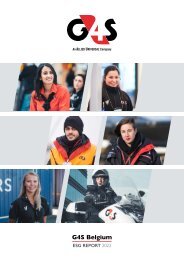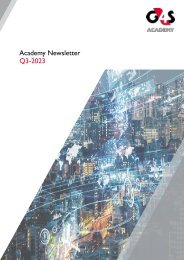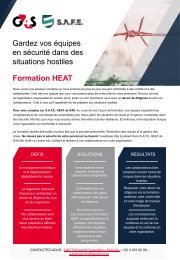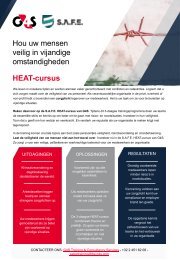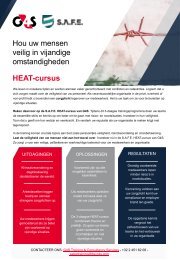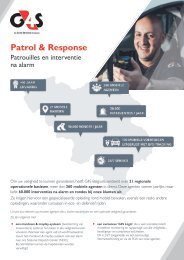G4S Academy Guide | Sustainable Security
You also want an ePaper? Increase the reach of your titles
YUMPU automatically turns print PDFs into web optimized ePapers that Google loves.
SUSTAINABLE SECURITY:<br />
8 CREATIVE APPROACHES
TABLE OF CONTENTS<br />
■ Introduction: Sustainability and <strong>Security</strong> Solution Design<br />
■ When It Comes to Sustainability, Less is Sometimes More<br />
■ 8 Creative Ways to Approach <strong>Sustainable</strong> <strong>Security</strong><br />
1. Use Naturally Existing Features<br />
2. Manage Sites Remotely<br />
3. Employ Humans Instead of Robots<br />
4. Apply Defensible Space Theory<br />
5. Don’t Throw Away or Store Old Work Devices<br />
6. Use Sound in Innovative Ways<br />
7. Use Passphrases Instead of Passwords<br />
8. Go Looking for Problems<br />
■ <strong>Sustainable</strong> Choices Lead to Long Term Value<br />
■ Conclusion: Sustainability is an Ongoing Process
INTRO: SUSTAINABILITY AND SECURITY<br />
SOLUTION DESIGN?<br />
Sustainability is an ongoing puzzle - a delicate balancing act between profitability, long-term functionality and<br />
doing the right thing.<br />
After all, there’s only one earth and striving for sustainability will help preserve the planet and its resources for<br />
future generations.<br />
But it’s not always easy and the security industry faces its own unique challenges when it comes to sustainability.<br />
For example:<br />
■ Often large security company fleets are required for transport between client sites. While many companies<br />
are upgrading to electric vehicles, it still takes time to offset these emissions.<br />
■ The physical technologies used, such as CCTV cameras and other electronic equipment, create carbon<br />
emissions and may also leak toxins into the environment when improperly disposed of.<br />
■ <strong>Security</strong>-related data alone needs a huge amount of online data storage space for videos, files and photos.<br />
Unnecessarily stored data is estimated to consume 16,000+ tonnes of carbon every year.<br />
■ Corporate uniforms create approximately 15,000 tonnes of waste every year.<br />
Discovering sustainable solutions to these problems and designing sustainable security solutions will require an<br />
abundance of one of the earth’s most precious resources: creativity.<br />
1
WHEN IT COMES TO SUSTAINABILITY, LESS IS<br />
SOMETIMES MORE<br />
When it comes to solving the problem of making our security approach more sustainable, the tendency has been<br />
to throw more money and technology at the problem. It’s tempting to conclude that if we can just develop the<br />
latest tech, we’ll be able to perform better and more efficiently.<br />
However, we should let go of the idea that technology is always the answer, or that the problem needs to be<br />
solved in the conventional way.<br />
In some situations, we actually benefit from looking back at simpler solutions that mankind has been using for<br />
hundreds of years. When we take a more creative and innovative approach, we often come up with solutions that<br />
are not only more sustainable - but also simpler, more robust and more affordable.<br />
The following are eight creative and innovative approaches to security that allow teams to operate in a more<br />
sustainable way.<br />
2
8 CREATIVE WAYS TO APPROACH SUSTAINABLE SECURITY<br />
1. Use Naturally Existing Features<br />
What if nature has already given you all the features you need to<br />
make a site more secure? Taking the natural features of a location into<br />
account when designing security solutions can save resources while<br />
preserving the environment.<br />
For example, building your property next to a natural feature such as<br />
a lake, dense woodland or undulating ground ensures that no vehicles<br />
can approach from that direction. A water source directly next to<br />
the building is also valuable in the event of a fire or for other essential<br />
services such as cooling.<br />
Plants or dense shrubbery can also serve as useful tools in your security<br />
design. A dense row of trees can be a great way to deter vehicles from<br />
approaching, while also adding shade and improving air quality.<br />
In fact, there is evidence proving that simply planting trees in an area<br />
will reduce crime. The research shows that a 10% increase in trees<br />
within an area roughly equals a 12 percent decrease in crime. (This<br />
could be considered the opposite of the Broken Windows Theory, which states that visible signs of crime or<br />
destruction create an environment that encourages further crime and disorder.)<br />
This can also apply to the topography of a site. For example, if you build your facility into a hillside it<br />
will naturally be secured on three sides. If you build on a high point, you’ll have maximum visibility of the<br />
surrounding area. (There’s a reason why castles and forts have been built in these naturally defensible positions<br />
for thousands of years.)<br />
This approach is doubly beneficial. Not only does it save the energy and resources it would cost to install<br />
man-made features, it prevents the destruction of natural features and the loss of their benefits. For example,<br />
bulldozing the trees to install a row of bollards would not only cost more, but bollards don’t offer the benefit<br />
of giving out oxygen.<br />
3
2. Manage Sites Remotely<br />
While there has been a global push towards remote<br />
work over the last several years, the COVID-19<br />
pandemic forced many organisations around the<br />
world to take the leap. Remote work has now<br />
become more common than ever. According to a<br />
survey by Upwork cited in <strong>Security</strong> Magazine, 42.8%<br />
of the American workforce remains fully remote.<br />
Working from home has proven to make workers<br />
more productive and to improve employee retention<br />
rates. It’s also much more sustainable as well. Of<br />
course, security officers themselves can’t work from<br />
home as they have to be on site to do their jobs.<br />
However, there are often many other supporting<br />
roles that can be performed from home, which will<br />
reduce commutes, decrease carbon emissions and<br />
lower energy usage.<br />
Seek out any opportunity to have meetings online<br />
rather than in person, as this reduces the need for<br />
unnecessary business travel. If meetings absolutely<br />
must be held in person, the team should prioritise<br />
public transport or car sharing.<br />
AI-based security camera technology can be useful<br />
in achieving this aim, because they aid human teams<br />
by identifying and flagging unusual behaviour. When<br />
you have an AI-powered security system monitoring<br />
for intrusions or abnormal behaviour, there is less<br />
need for a huge team on site to check the real-time<br />
video streams.<br />
Of course, while remote working models offer<br />
higher productivity, lower costs and sustainability<br />
advantages, they also have their downsides. Remote<br />
workers can feel isolated and can be at higher risk<br />
of burnout due to the difficulty of separating work<br />
from leisure time.<br />
If you implement a work-from-home model, it<br />
will be essential to build in safeguards for this and<br />
provide your employees with the necessary support.<br />
4
3. Employ Humans Instead of Robots<br />
Although the trend has been towards automating<br />
everything that can possibly be automated,<br />
sometimes a human being really is the most<br />
effective AND sustainable choice for the job.<br />
For example, Mercedes Benz has recently turned<br />
the clock backwards at its flagship factory by<br />
reducing their dependence on automation and<br />
hiring more humans. Of course, robots are highly<br />
efficient at doing one repetitive, programmable<br />
job over and over again. However, humans are<br />
better able to handle the bespoke complexity of<br />
the customisation options available for the S-Class<br />
saloon model.<br />
There are so many different variables that go into<br />
manufacturing these cars, such as different types of<br />
cup holders, trims, wheels, etc. Robots are simply<br />
not as flexible and adaptable as humans when it<br />
comes to these individualised production orders.<br />
Automation CAN be a better option in some<br />
circumstances, but not all. This is another example of a case in which more technology doesn’t necessarily equal a<br />
better outcome. There are certainly applications for this idea in the security industry as well.<br />
Before investing in technology to solve a security problem (which has energy and production costs), ask yourself<br />
whether the job could be done more sustainably by a human. In fact, even with the recent developments in AI,<br />
often a human is still the best detection and response solution for non-recurring situations.<br />
5
4. Apply Defensible Space Theory<br />
Defensible Space Theory is a concept developed by architect and city planner Oscar<br />
Newman. He writes about how architecture plays an incredibly important role in<br />
increasing or reducing crime. The theory, expanded upon in his book Defensible Space<br />
from 1972, states that security depends both on physical elements as well as the social<br />
interactions of those in the environment.<br />
In the book, Newman writes about a study in New York that found higher crime rates<br />
in high-rise housing projects compared to low-rise housing complexes. Newman’s<br />
theory is that in the high-rise buildings, the residents were more disconnected from<br />
their neighbours and felt no personal responsibility for the building as a whole.<br />
In contrast, in the smaller low-rise complexes, residents could see their<br />
neighbourhoods and the common spaces more easily and felt a sense of<br />
ownership over the space. Plus, the design of the space made intruders feel like<br />
they were being watched, so they were less likely to feel like they could get away<br />
with a crime.<br />
Defensible Space Theory is applicable to any built environment, from a<br />
commercial premise to a warehouse to an apartment building. By keeping<br />
it in mind when designing security solutions, you can use resources more<br />
effectively and maximise results. When done well, people who are using the<br />
space will hardly feel the presence of the security measures because they<br />
will be in harmony with the environment.<br />
For example, sculptures and seating areas can serve as perimeter and<br />
hostile vehicle mitigation elements around a building, yet don’t appear<br />
to be security. Mixing residential and commercial spaces alongside<br />
well-lit pathways and shared spaces means that there will be residents<br />
to keep a watchful eye 24/7.<br />
Plus, these principles of design often have the bonus side effect of<br />
fostering community and making residents and workers feel less<br />
isolated and alone.<br />
6
5. Don’t Throw Away or Store Old Work Devices<br />
Throwing away old work computers is a security risk, as criminals<br />
can take advantage of carelessly discarded equipment. It’s also terrible<br />
for the environment, as hazardous materials inside them can leak out.<br />
Electronics are full of toxins such as cadmium, lead and arsenic. If these<br />
materials get into a landfill, they can leach into the soil and water supply<br />
and cause serious harm to humans and wildlife.<br />
But you also don’t want to store old equipment away in a cupboard or<br />
storage room either. Since no one is really keeping an eye on those old work<br />
phones or laptops, it would be easy for someone to take one for the night<br />
without anyone noticing and hack into it.<br />
The best and most sustainable thing to do is use a certified recycling company<br />
with a shredder that will destroy the harddrive. They will then recycle the device<br />
in the correct way so that the harmful materials don’t damage the environment.<br />
Make sure the recycling company you choose has been certified by <strong>Sustainable</strong><br />
Electronics Recycling International. This is a serious certification that takes 8-12<br />
months to complete and ensures that all electronics are recycled in a way that is<br />
environmentally friendly and sustainable.<br />
7
6. Use Sound In Innovative Ways<br />
Sound is a simple tool that is incredibly low cost and<br />
creates no pollution or byproduct, but has been proven<br />
to improve security.<br />
When shopkeepers in the UK had a problem with<br />
teenagers drinking and loitering outside their shops and<br />
posing a security threat, they used a device known as<br />
the “Mosquito”. It emits an annoying high-pitched sound<br />
(somewhat like a dog whistle) that can only be heard by<br />
young people.<br />
Anyone older than their mid-20s will not be able to hear<br />
the tone, but the younger crowds who were causing<br />
issues found it so irritating that they left the shops alone.<br />
This wasn’t the first time businesses used sound to deter<br />
loitering and antisocial behaviour. Anne Midgette writes<br />
for the Washington Post about how the Port Authority<br />
Bus Terminal in New York played classical music in their<br />
waiting areas. The article also mentions how, when the<br />
London Underground began playing classical music in<br />
their stations in 2005, “verbal abuse and physical attacks<br />
by young people” decreased by 33%.<br />
Anne writes; “Playing music in any space redefines that<br />
space, much as painting a mural on the side of a building<br />
affects the space around it: It is transformed from a<br />
no-man’s-land to a place with an identity, a kind of selfawareness.”<br />
When the music gives the space this type of selfawareness,<br />
those who might act in antisocial ways within<br />
the space feel more self-conscious about doing so. The<br />
music reminds them that the space is not theirs.<br />
But of course, it’s important to be careful with this<br />
type of approach. It can be a clever and environmentally<br />
friendly way to reduce security incidents, but it can<br />
also teeter into dystopian territory if it is not used in<br />
a compassionate way. Take for example, the homeless<br />
shelter and safe drug consumption site in downtown<br />
Price George, British Columbia that received criticism for<br />
blasting a three-minute opera clip on repeat.<br />
This approach was so obtrusive and extreme that it came<br />
across as cruel, especially in a space designed to help<br />
marginalised members of the community. While sound<br />
and music can be employed in creative ways to improve<br />
security sustainably, it has to be done with empathy.<br />
8
7. Use Passphrases Instead of Passwords<br />
The comic below is a great example of how something simple and human-focused is actually more secure than<br />
the alternative. Simply changing the way we create passwords could help security systems operate better AND<br />
be easier to use.<br />
The accepted practice when it comes<br />
to passwords is to use a long string<br />
of random letters and numbers. But<br />
it turns out that this actually doesn’t<br />
make sense, for humans or for<br />
computers.<br />
By training everyone in the company<br />
to use passphrases rather than<br />
passwords, you could help make<br />
your databases more secure against<br />
hacking - in a way that consumes<br />
absolutely no extra resources. Also,<br />
since these passphrases are easier<br />
for humans to remember, you’ll<br />
also spend fewer resources on tech<br />
support issues where employees have<br />
forgotten their passwords.<br />
In fact, you’ll likely find that your facilities are more secure. <strong>Security</strong> architect Avi Douglen has a “Rule of Usability”<br />
that is so famous it’s been printed on a t-shirt.<br />
“<strong>Security</strong> at the expense of usability comes at the expense of security.”<br />
In other words, if your secure system isn’t easy for people to use, people won’t use it. They will find a way to bypass<br />
the system and use an easier process that doesn’t slow them down, thus negating the security benefit completely.<br />
9
8. Go Looking For Problems<br />
The typical approach to “staying up to date” with security threats is to keep an eye on the information sources<br />
and watch out for any newly discovered vulnerabilities that someone else has already discovered and told the<br />
world about.<br />
But there’s a problem with this approach. Hackers are creative and they are always looking for fresh ideas and<br />
new ways to carry out their attacks. They use the newest technology, as well as exploiting human vulnerabilities<br />
in unique ways to gain access.<br />
When it comes to security, you’ll protect yourself more effectively if you can be creative as well. Instead of just<br />
taking a reactive approach, you’ll need to be proactively thinking outside the box and looking for situations where<br />
potential problems might occur.<br />
This is a mindset that can be instilled within everyone on your team, so that the entire approach to security<br />
changes. Encourage your security staff not to just ask the same old questions and expect the same old answers.<br />
They should be curious and go looking for potential problems.<br />
You can also hire for this quality. Instead of seeking out people who follow the rules and do things how they<br />
have always been done, look for candidates who demonstrate out-of-the-box thinking. By being inquisitive and<br />
creative, you’ll be more likely to spot problems before they happen and save hassle, time and resources.<br />
10
SUSTAINABLE CHOICES LEAD TO LONG TERM VALUE<br />
Many security firms will begin striving towards sustainability efforts because they make logical sense to the<br />
company’s bottom line, or because their clients and customers demand it. When you integrate sustainability into<br />
all key decisions, you future-proof the company.<br />
<strong>Security</strong> firms often work with global businesses with corporate sustainability plans and net zero carbon goals.<br />
According to McKinsey & Company, sustainability can reduce costs and improve operating profits by up to 60%.<br />
In these business partnerships, there is a duty to uphold high sustainability standards, as this is something that<br />
clients expect. The pressure is high to seek innovative ways to champion sustainability across all products.<br />
In addition, consumers are also increasingly sustainability-conscious and this factors into their brand loyalty.<br />
According to research by Oracle, 70% of people claim that they would cancel their relationship with a brand that<br />
didn’t take sustainability seriously.<br />
But the responsibility of making sustainable choices isn’t simply about looking good for clients and customers. It’s<br />
not just a business decision, it’s a moral one too.<br />
With this in mind, all security and safety measures should be considered within the context of sustainable design.<br />
Realistically, budgetary and logistic restraints often require compromise and tradeoffs.<br />
With creative thinking and unconventional ideas, we can offer alternatives that improve security<br />
while reducing waste, consuming fewer resources and allowing our facilities to operate more efficiently.<br />
11
CONCLUSION: SUSTAINABILITY IS<br />
AN ONGOING PROCESS<br />
Sustainability is never just a one-and-done thing. It’s an attitude<br />
you should always have, a lens you can use to view every activity<br />
of your organisation. It’s an ongoing challenge and something<br />
to be constantly addressing and tweaking for best results.<br />
Companies that approach sustainability and security<br />
in this open and innovative way will be the ones who<br />
successfully adapt and thrive. As the examples<br />
above show, the most sustainable solution doesn’t<br />
necessarily have to be the most complex or<br />
expensive one.<br />
To learn more about how we can provide<br />
you with high quality sustainable security<br />
solutions, get a custom consultation<br />
for your business. You can talk to an<br />
expert on the <strong>G4S</strong> team by reaching<br />
out today at www.<strong>G4S</strong>.com.<br />
12
VALUE CREATED<br />
TOGETHER<br />
V1 DECEMBER 2022<br />
1013729432 © 2022 <strong>G4S</strong>, An Allied Universal ® Company





